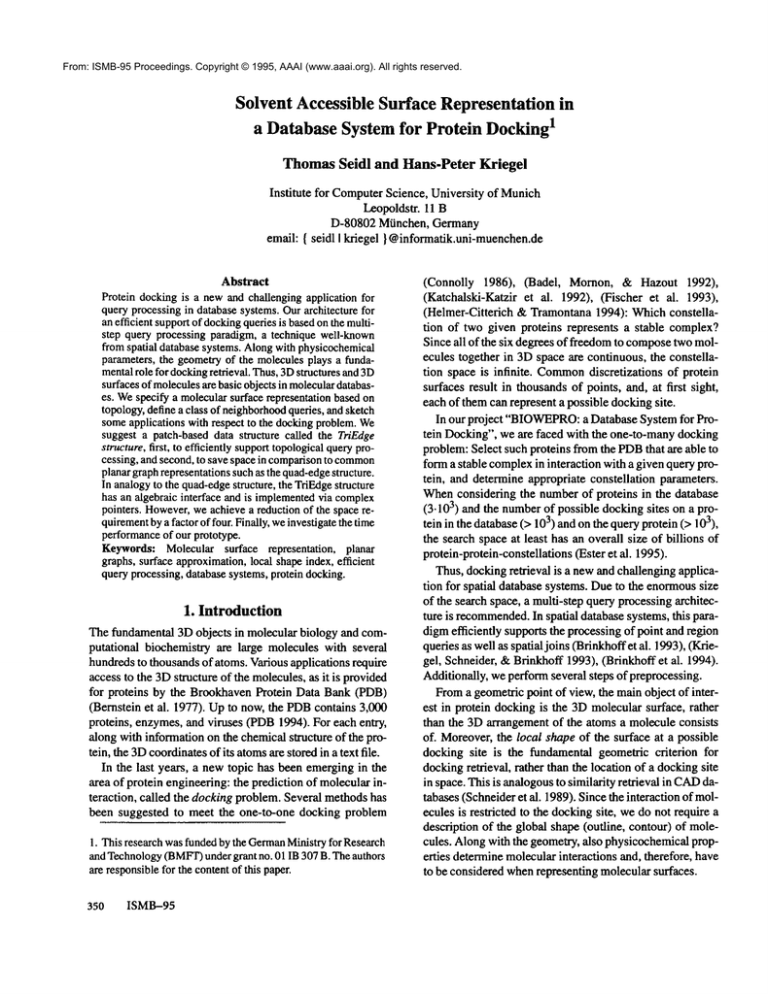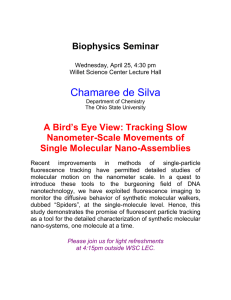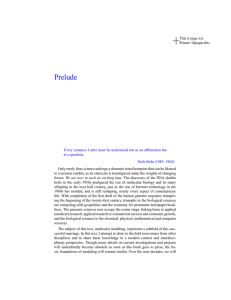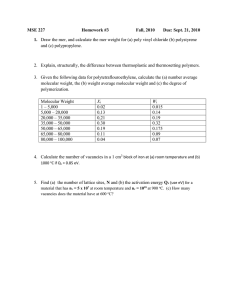
From: ISMB-95 Proceedings. Copyright © 1995, AAAI (www.aaai.org). All rights reserved.
Solvent Accessible Surface Representationin
Ia Database System for Protein Docking
Thomas Seidl
and Hans-Peter
Kriegel
Institute for ComputerScience, University of Munich
Leopoldstr. 11 B
D-80802 Miinchen, Germany
email: { seidl I kriegel } @informatik.uni-muenchen.de
Abstract
Protein dockingis a newand challengingapplication for
queryprocessingin databasesystems.Ourarchitecture for
an efficient supportof dockingqueriesis basedon the multistep query processing paradigm,a technique well-known
fromspatial databasesystems.Alongwith physicochemical
parameters,the geometryof the moleculesplays a fundamentalrole for dockingretrieval. Thus,3Dstructuresand 3D
surfacesof moleculesare basic objectsin moleculardatabases. Wespecify a molecularsurface representationbasedon
topology,define a class of neighborhood
queries, andsketch
someapplications with respect to the dockingproblem.We
suggest a patch-baseddata structure called the TriEdge
structure,first, to efficiently supporttopologicalqueryprocessing, and second,to save spacein comparison
to common
planargraphrepresentationssuchas the quad-edge
structure.
In analogyto the quad-edge
structure, the TriEdgestructure
has an algebraic interface and is implemented
via complex
pointers. However,
weachievea reductionof the spacerequirement
bya factor of four. Finally,weinvestigatethe time
performance
of our prototype.
Keywords:Molecular surface representation, planar
graphs, surfaceapproximation,
local shapeindex, efficient
queryprocessing,databasesystems,protein docking.
1. Introduction
The fundamental 3D objects in molecular biology and computational biochemistry are large molecules with several
hundredsto thousandsof atoms. Variousapplications require
access to the 3Dstructure of the molecules,as it is provided
for proteins by the BrookhavenProtein Data Bank (PDB)
(Bernstein et al. 1977). Upto now,the PDBcontains 3,000
proteins, enzymes,and viruses (PDB1994). For each entry,
along with informationon the chemicalstructure of the protein, the 3Dcoordinatesof its atomsare stored in a text file.
In the last years, a newtopic has been emergingin the
area of protein engineering: the prediction of molecularinteraction, called the docking problem.Several methodshas
been suggested to meet the one-to-one docking problem
1. Thisresearch wasfundedby the German
Ministryfor Research
and Technology
(BMFT)
undergrant no. 01 IB 307B. Theauthors
are responsiblefor the contentof this paper.
350
ISMB-95
(Connolly 1986), (Badel, Mornon, & Hazout 1992),
(Katchalski-Katzir et al. 1992), (Fischer et al. 1993),
(Helmer-Citterich & Tramontana1994): Whichconstellation of two given proteins represents a stable complex?
Since all of the six degrees of freedomto composetwo molecules together in 3Dspace are continuous, the constellation space is infinite. Common
discretizations of protein
surfaces result in thousandsof points, and, at first sight,
each of themcan represent a possible dockingsite.
In our project "BIOWEPRO:
a Database System for Protein Docking", we are faced with the one-to-manydocking
problem:Select such proteins from the PDBthat are able to
forma stable complexin interaction with a given queryprotein, and determine appropriate constellation parameters.
Whenconsidering the numberof proteins in the database
(3.103) and the numberof possible docking sites on a protein in the database(> 103)and on the queryprotein (> 103),
the search space at least has an overall size of billions of
protein-protein-constellations(Ester et al. 1995).
Thus, dockingretrieval is a newand challenging application for spatial database systems. Dueto the enormoussize
of the search space, a multi-step queryprocessingarchitecture is recommended.
In spatial database systems, this paradigmefficiently supports the processingof point and region
queries as well as spatial joins (Brinkhoffetal. 1993),(Kriegel, Schneider, &Brinkhoff 1993), (Brinkhoffet al. 1994).
Additionally, we performseveral steps of preprocessing.
Froma geometricpoint of view, the mainobject of interest in protein dockingis the 3D molecularsurface, rather
than the 3Darrangementof the atoms a molecule consists
of. Moreover,the local shape of the surface at a possible
docking site is the fundamental geometric criterion for
dockingretrieval, rather than the location of a dockingsite
in space. This is analogousto similarity retrieval in CAD
databases (Schneideret al. 1989). Sincethe interaction of molecules is restricted to the dockingsite, wedo not require a
description of the global shape (outline, contour) of molecules. Alongwith the geometry,also physicochemicalproperties determinemolecularinteractions and, therefore, have
to be considered whenrepresenting molecularsurfaces.
As we will see in section 3, molecular surfaces are
smooth but quite bumpy(tmeven). Since all bumpsare
similar atomic size, the selectivity of a local shape index
would be very low when based on infinitesimal neighborhoods. Instead, for each surface primitive (patch or point,
resp.), we collect its neighborswithin an appropriateradius,
and determine the local shape via a paraboloid as a simple
approximation.
Collecting neighbors requires access to adjacencyinformation, as it is provided by well-knowndata structures like
the quad-edgestructure (Guibas &Stolfi 1985). In this paper, we propose a newbasic technique to represent molecular surfaces, reducingthe storage requirementby a factor of
four. Since our methodis based on topology, it supports effective and efficient processing of queries on the molecular
surface structure. Weformally introduce the conditional
neighborhoodquery, and give an algorithm to process it. As
an application, local surface approximationis consideredin
detail. Wehnaplementedour methodin C++on top of the
object-oriented database managementsystem ObjectStore
(Orensteinet al. 1992).
Thepaper is organizedas follows: In section 2, we shortly present our architecture to p_rocess dockingqueries. In
section 3, we give a specification to represent molecular
surfaces and, in section 4, we introduce the neighborhood
query and someapplications with respect to the docking
problem.In section 5, the TfiF_Age
data structure is presented that supports efficient processing of neighborhoodqueries. Section 6 contains first evaluation results, and
section 7 concludes the paper with a summaryand an outlook to future work.
cal extremefeatures as centers of the segments.Weassume
these segmentsto represent potential dockingsites.
The preprocessing steps begin with calculating geometric and physicochemicalfeatures for a set of points on the
surface in a location independentway. The features of the
segments, aggregated from the features of the points, are
complemented.Then, the segmentsare inserted into a multidimensional access method, called feature index (A1dinger et al. 1994)for an efficient retrieval of dockingpartners from the set of segmentsof all the proteins in the
database. Obviously, representation methodsfor surface
segmentsare the moreappropriate, the morethey are independent fromlocation and direction in space, thus being invariant with respect to translation and rotation. Figure1 illustrates the steps of our query processingarchitecture as
described below in moredetail.
[, computation
of features for surfacepoints on the [
[ query protein
l
]. aggregationof surface points with similar features to |
[
[segments
oin of the segmentsof the databaseandthe queryprot~]
~
~.
reflnemen~step
] ¯ overlayof the segmentsto determinethe
[ geometricconstellation parameters
evaluationof the similarityof the 3Dregions
~
( physlcochemlcal valldatlon
2. A QueryProcessing Architecture for
Protein-Docking
The enormoussize of the constellation space implies a
great challenge to efficient queryprocessing. To reduce the
set of candidate complexesstep by step in an efficient way,
we provide our dockingsystem with a multi-step query processing architecture. This technique causes very small cost
per constellation in the filter step, reducingthe set of possible docking candidates drastically when comparedto the
overall size of the constellation space. Since the quality of
the remaining candidates is not expected to be very good,
further refinement steps have to be performed. These may
cause higher cost per candidate pair, but haveto ensure high
quality results.
Further reduction of the constellation space is achieved
by managinggroups of points instead of the points themselves. Wecall such groups segments, and create them by
collecting points with similar features. In analogy to the
knobs and holes of (Connolly1986), we use points with lo-
)
Figure 1: query processing architecture
(1) Filter step using geometricfeature vectors. In analogy to the preprocessingsteps, features and segmentsare determinedon the queryprotein. For the retrieval of segments
from the database that are complementary
to the query segments, we store the segments in a second feature index
without performing complementation. A multidimensional
join is performedwith the twofeature indices, yielding candidate pairs. Eachpair consists of a segmentfrom the database and a segmentof the query protein, both having similar features wheresimilarity is defined by a given threshold.
(2) Ref’mementstep using 3D geometry. For the comparison of the 3Dgeometry, we need the exact geometryof the
constellations. Therefore, the segmentsof a candidate pair
are fitted togetherto determinethe best relative position representing a complexin 3Dspace. Then, somesimple evaluations of the geometricsimilarity are performed,and constelSeidl
351
lations are discarded for whichthe protein pairs overlap on
somesite. Theresult of the refinementstep is a set containing
geometricconstellation parametersfor pairs of proteins.
(3) Validation of the constellations with respect
physicochemicalproperties. In the first refinement step of
query processing, only geometriccriteria are consideredfor
docking candidates. The physicoehemiealproperties of the
surface like hydrophobicityand electrostatic potential also
have a high degree of relevance for docking. This is due to
the fact that these interactions dependon the relative position of two proteins whichis only determinedin the refinementstep. In the last step of query processing, constellations are returned that fulfill both, the geometricand the
physico-chemicalcriteria for the dockingof two proteins.
Since no algorithm is yet knownto classify a predicted
complexto be stable in reality with a high probability, the
results delivered from the dockingsystemfinally have to be
tested by an biomolecular laboratory experiment. Thus, we
cannot find final results in an early step of queryprocessing,
but mayonly discard constellations whichare recognizedto
represent no valid complex.
3. Molecular Surface Representation
Weconsider the molecularsurface to be the solvent accessible surface for a solvent proberadius ct following(Richards
1977). Various implementationsfor the calculation of molecular surfaces are published (Connolly 1983a), (Varshney, Brooks, & Wright 1994), (Halperin & Overmars
1994). Molecular surfaces have a strong regularity, and
they only consist of three types of patches: Convexspherical patches, saddle-shaped rectangles, and concavespherical triangles (figure 2). Thesetypes dependon the number
of atoms that the probe sphere is in simultaneous contact
with whenrolling over the molecule. Since the algorithms
enforce the atoms to be in general position, ensuring the
probe sphere never being in simultaneous contact with
morethan three atoms, the complexityof the algorithms is
reduceddrastically. Obviously,this also holds for the representation of molecularsurfaces.
At first sight, a patch-basedrepresentation of molecular
surfaces seemsto be difficult to manage:Thereare different
types of patches with a different numberof vertices, etc..
Thus, triangulated surface representations are quite commonto be used for dockingpurposes, and also for visualization. However,there are strong advantages for the patchbased representation: First, for a particular moleculeand a
given proberadius ix, the solvent accessible surface is well
defined in its structure and its shape. Second,for any given
point density, the patchworkcan be refined to a dotted surface and a triangulation, but not vice versa. Third, every
patch is homogeneouswith respect to the (infinitesimal)
curvature, and the normalvector of a surface point is deter352
ISMB-95
Figure 2: surface of a portion of hemoglobin,
from (Connolly 1983b)
minedby the geometric parameters of the patch it belongs
to, i.e. via the associated atom sphere, toms, or probe
sphere, respectively. Overall, we prefer a patch-basedsurface representation rather than a point-based methodor an
arbitrary triangulation.
The articles describing molecularsurface calculation as
found in molecular biology (Cormolly 1983b), computer
graphics (Varshney, Brooks, &Wright 1994), and computational geometry(Halperin &Overmars1994), do not mendon their surface representation method. In (Halperin
Overmars1994) only, there is a hint that extendedvan-derWaalssurfaces are representedby the quad-edgestructure. In
the following, we present a patch-based representation for
molecular surfaces providing access to the patches via an
edge algebra. Suchan edge algebra has been suggested for
the quad-edgestructure by Guibasand Stolfi (Guibas&Stolti
1985)to represent planar graphs such as molecularsurfaces.
Asan interface for our surface representation, we specify
a set of edgefunctions. Anillustration of the operations is
given in figure 3. Weimplement
this specification as a set of
C++classes for the object-oriented database system ObjectStore. However,to demonstrate the relations between
the functions, we give an algebraic specification with axioms. From the EDGE-9 EDGEfunctions, Sym and LEdge
or Symand Lnext are primitive, the others can be derived
with respect to the axioms:
SPEC MolSurface;
TYPES EDGE, FACE, VERTEX;
FUNCTIONS
Sym, LEdge, REdge,
Lnext, Lprev: EDGE --> EDGE;
Left, Right :
EDGE --> FACE;
Orig, Dest :
EDGE --> VERTEX;
any_edge:
FACE --> EDGE;
any_edge:
VERTEX -> EDGE;
EDGE e, FACE f, VERTEX
e. Sym() .Sym() ==
e.Redge() .LEdge() ==
e. Lnext()== e. Sym() .REdge()
e. Lprev() == e.LEdge().Sym()
e. Sym() .Orig() == e.Dest()
e. LEdge() .Orig() == e.Orig()
f.any edge().Left() ==
v.any edge() .Orig() ==
END MolSurface.
AXIOMS
(for
v)
Figure 3: Illustration of the MolSurfacealgebra
In addition to the algebra, wedefine iteration statements
to assign all the edges ¯ arounda face or a vertex counterclockwiseto an edge variable e:
forall_around_face
(e, face) {... } and
forall_around vertex(e,vertex) {...}.
Thereby, the edge cycle is traversed by the Lnextor
LEdge
function,
resp.,
until
thefu~tedgeisreached
a secondtime.
In this paper, we focus the specification onto the topological structure of molecularsurfaces. To yield the location of
the vertices and somerepresentative points of the patches,
further functions provide access to geometric attributes,
e.g. location:VERTEX--) 3D_POINT,and representative:
FACE-~ 3D_POINT.
Similarfunctions
deliver thematic attributes and shape information. This approach results in a representation hierarchy as shownin
figure 4.
. .... ~:~!{:~:.
.:.:.-~.-.’:--
: ......
!~:7-:~9..
~:: ........
~..~.:r
~~’2~~~~i::::
Figure 4: topology-based representation of
molecular surface
Upto here, we specified our patch-basod representation
of molecular surfaces. In section 4, we showbowneighborhoodqueries are performedbased on this specification, and
in section 5, we explain our MolSurfacealgebra implementation.
4. Application
for Protein
Docking
In this section, wepresent someapplications that require topological information. Weintroduce the neighborhoodquery, and apply it to local surface approximation,surface segmentation, and determination of local exlxema.
A neighborhood query is specified as a conditional
neighborhood,no(P), that will be selected from a surface
the database. Tlaerefore, ncfP) is determined by a center
patch or point p, and by the conditionc that can be a euclidcandistancecriterion, a similarity criterion, or anyother binary relation. For a surface graph g, nc(P) is defined to
the maximal connected subgraph of g restricted to the
patchesv (or points, resp.) that fulfill the conditionc(v,p).
Thus, for each v ~ nc(P), one of the following properties
holds: (i) c(v,p) and (v--p), or (ii) c(v,p) and a neighbor
is in nc(p). In other words,no(p) containsonly patchesp
(1) are reachablefromp within he(P), and (2) fulfill the
dition c togetherwith p: c(v,p).
Various applications of the general concept of neighborhood queries can be thought of. The following examples
showsomeof themin the domainof protein engineering.
(1) Local approximationof the molecular surface. For
the calculation of a local shape index at a patch p on our
patch-based surface representation, we follow (Zachmann
et al. 1992) and approximatethe neighborhoodofp by a paraboloid. As mentionedabove, infinitesimal curvatures are
not specific. Thus, we provide control over the locality of
the approximationby a radius parameterr. A so called euclidean neighborhoodquery, nr(P), consists in the selection
of all the patches that are reachable from p within the euclidean distance r. In this ease, the condition c simplyis a
comparison:
c(v,p) = ’disteuelid(v,p) < r’ (el. figure
::::::::::~:.
. ....¢:
!i!!
!iiiiiiiiiii
iiiiiiiiiiiiiiii!
iiiiiiiiiiiii!
!iiiiii
!iiii!ii
Jiiiiii
iiiiiiiiiiiiii
iiiiiiiiiiiiiiii
iii
iiii!iiiiiiii!iiii
Figure 5: surface appro,dmationfor different
neighborhoodradii r I and
2 r
(2) Segmentationof molecular surfaces. Weperform segmentation via a region growingalgorithm. For each of the
patches in a sprout set, we perform a ueighborboodquery
specified by a similarity criterion, e.g. twopatchesare sireSeidl
353
ilar if they both are saddle-shaped,or if they have the same
sign for the electrostatic potential. The resulting segments
may have various extensions on the surface and in 3D
space, since they are not boundby a spatial distance criterion. Also, they may overlap. Whenproviding a similarity
criterion with a very low significance, a single segmentcan
cover the whole surface.
(3) Determinationof local extrema. In (Connolly 1986),
knobs and holes are defined to be surface points having an
extreme solid angle with respect to their neighbors. As a
generalization, our neighborhhoodquery supports specifying arbitrary neighborhoodradii leading to different degrees of locality. Thus, various radii can be investigated
with respect to their appropriateness for the purpose of
dockingretrieval.
Neighborhood query processing. Based on the surface
representation specified in section 3, we performneighborhoodquery processing via a graph traversal algorithm:
void Neighborhood
( PATCH* p, CONDITION* cond,
os_Set <PATCH*>& result)
{
os_List <PATCH*> open;
PATCH *h, *v;
result.clear();
if (cond->eval(p,p))
(
open.insert(p);
result.insert(p);
while (h = open.remove_first())
// expand current patch h:
forall_around face( e, h
(
v = e.Right();
if (not result.contains(v)
and cond->eval(v,p))
result.insert(v);
open.insert(v);
}
}
return;
// result is refparam
)
Thebehavior of the algorithm is controlled by the insertion methodinto open: Wheninserting new patches at the
354 ISMB--95
end, a breadth-first traversal is performed,whereasan insertion at the beginningwouldresult in a depth-first traversal.
5. The TriEdge Data Structure
Upto here, wedeclaredour objects of interest, specified access operations, and presented a basic query class with applications. Now,we illustrate our approach to implement
the objects and their operations in a very efficient way.
The quad-edgestructure (Guibas &Stolfi 1985) is quite
commonfor the representation of planar graphs such as
molecular surfaces. The implementation is based on edge
records containing four pointers to the two boundingvertices and the two co-boundingfaces, and four complexpointers to the edgesthat are adjacent via the origin and destination vertex in clockwise and counterclockwise direction.
This concept is similar to the doubly-connected-edge-list
(DCEL)from (Preparata &Shamos1985), with two differences: First, the quad-edgestructure is defined via an algebra, leading to a morecomfortable access to edges, their
symmetric and dual edges, in comparison to the DCEL.
Second, the complexpointers of the quad-edge structure
contain a simple pointer to an adjacent edgerecord, and additionally, unlike a DCEL
entry, an offset value representing the viewto the referencededge. Exactly this idea of an
algebraic interface together with a complexpointer concept
is used for our TriEdgestructure as described below. This
approach is well supported by the object-oriented data
modeland leads to an easy integration.
However,the quad-edge structure requires 36 bytes per
record, whenadjusted to a multiple of four. Real molecular
surfaces have a size of somethousand patches and edges,
for a common
probe radius of 1.4/i which is the size of a
water molecule. Therefore, the storage requirement for the
surface topology information of a single molecule is hundreds of kilobytes (cf. table 1). Since the numberof proteins in the PDBcurrently is 3,000 (PDB1994), the size
our 3D protein database for docking retrieval comesinto
the range of gigabytes. Therefore, an efficient implementation is crucial.
number numberof number size of quadprotein of atoms
patches of edges edge records
2pab.a
872
3710
7380 260 kbytes
2pab.b
872
3776
7524 265 kbytes
2ptc.e
1629
5606
11160 393 kbytes
2ptc.i
454
1990
3972
140 kbytes
2sni.e
1983
6220
12396 436 kbytes
2sni.i
513
2116
4224
149 kbytes
Table 1: surfaces of real proteins
Our approach to implementthe MolSurfacespecification
consists of twosteps: First, wereduce the complexityof the
representation by mappingthe molecular surface graph to
an equivalent but simpler graph structure. Second, we exploit the strong regularity of the new structure as a key
property for an efficient representation. Overall, we save
space and, therefore, time for the reduced volumeof data
transfer within the database system. In this section, we explain our technique, whereasin section 6, the space reduction factor is shownin detail, and a first runtimeevaluation
of our prototype is presented.
The main observation concerns the structure of molecular surfaces and the role of the saddle patches: Everysaddle
patch connects two convexpatches and two concave triangles. Both types, the convexand the concave patches, are
surroundedby cycles of saddle patches. This is analogous
to faces and vertices of a planar graph that are surrounded
each by a cycle of edges. Weexploit the analogy to develop
a new storage methodfor molecular surfaces, and call the
new structure the simplified surface graph (SSG, cf.
figure 6), whichis topologically equivalent to the accessible surface as defined in (Richards1977).
molecular
surface
,,,,,,
corner point
patch
border arc
concavetriangle
saddle
rectangle
convex patch
g"Ph
vertex
edge
face
Figure 6: detail of a molecularsurface:
MolSurface edges and SSGedges
face
edge
face
face
A secondkey observation leads us to a further reduction
of the storage space. Since an SSGis a planar graph, we
coulduse the quad-edgestructure to store it in the database.
However,we can exploit a basic property of an SSG:All of
the SSGvertices havea degree of three, since there are only
triangles amongthe concavepatches, due to the general position of the atoms: e. LEdge( ) 3 = e for every EDGE
Therefore, we store the edge cycles around the SSGvertices in arrays with a fixed length of three, rather than using
any dynamicstructure. This leads us to the TriF_~gestructure whichconsists of records that contain three SSGhalfedges, all of thembelonging to the same SSGLEdgecycle.
Similar to the quad-edgestructure, an edge is represented
by a complexpointer that consists of a simple pointer to the
TriEdge record, and of a view that specifies which SSG
half-edge of the LEdgecycle is represented (cf. figure 7).
-~
TriEdge t] F
SSGedge
vertex
Table 2: relationship betweenmolecular surfaces
and the graph structures
EDGE
TrlEdoe*t I
view
v
MolSurface edge
simplified
surfacejgraph
MolSurface
EDGEefO] EDGEe{11 EDGE
e{2~l FACE
frO}
TdEdge12
,..
I
all
Like the molecular surface, also the SSGis a planar
graph, consisting of vertices, edges, and faces. For molecular surfaces, the vertices are mappedto corner points, the
edges to arcs, and the faces to patches. However,for the
SSG,we associate the vertices to the concavetriangles of
the molecularsurface, the edges to the saddle patches, and
the faces to the convexpatches (cf. table 2). Accessing
patch or vertex of the molecular surface via this mapping
can he performedin O(1). The numberof edges to be stored
is reduced drastically: Every edge of a molecular surface
belongs to exactly one saddle, and every saddle is boundby
four (molecular) edges. Obviously, a molecular surface
graph has four times as manyedges as saddle patches, and,
therefore, four times as manyedges as the SSG.
FACE
f(6}
Point
p(1)
Point p(2)
Figure 7: the TriEdgedata structure
A TriEdge record contains three complexedge pointers
to represent the connectivity information. Dueto the mapping from SSGto molecularsurface, a TriF_zlge record has
to provide access to seven patches: Oneconcavetriangle as
an image of the SSGvertex, three saddle patches as images
of the three SSGedges, and three convexpatches as images
of the SSGfaces that are adjacent to the saddles. Since the
Seidl
355
comerpoints are shared betweenthe patches, we associate
themto the TriEdgerecords rather than to the patches.
For molecular surfaces, a TriEdge record represents
twelve half-edges (cf. figure 8a) and, therefore, requires the
viewv being in the rangeof [ 0.. Xl ]. Since all of the elements of an LEdge cycle are represented by the same
TriEdge record, the LEdgeoperation requires no dereferencing of the TriEdgepointer of an edge, but only a change
of the view v. This function is the samefor all edges and,
therefore, can be carried out via lookupin a constant table
LEDGE
: [ 0.. 1 X ] --> [ 0.. X 1 ], implementedsimply as
an array. For the Symoperation, dereferencing a TriEdge
pointer is required in six cases, in the other six cases a
changeof the view is sufficient. Whenprovidingfurther arrays SYM,LEFT, and OR/G, the basic MolSurface operations are implemented
as follows (cf. figure 8b):
LEdge
MolSurface
: (t,v) --~ (e., r.,lCl:~E[v])
SymMolSurface
:
(t.,v) ---> if (v >
t:hma (t, St’M[v])
el=e sh, m((*t).o[v/2l,v)
Left MolSurface
:
(t,v) -~ (*t).f[LEFT[v]I
OrigMolSurface
:
(t,v) ~ (*t).p[ORIO[v]]
a)
®yll
®
®
/3
b)
view
LEDGE
SYM
LEFT
0
6
ORIG
o0
1 2
2 8
3 4 5 6 7 8
4 10 0 11 1 7
7 6 9
9 10 11
3 9 5
8 11 10
are referencedby 4-byte pointers, and the records being adjusted to a multiple of four bytes. Let e denote the overall
numberof edges on the molecular surface. Table 3 shows
the reduction of storage space for molecularsurfaces by the
factor 3.9 when considering topological information as
well as references to the patchesand their corner points.
storage
MolSurfvia SSGvia
requirement
quad-edge quad-edge
edges
4
4
references
SSGvia
TriEdge
3
per record comers
to...
2
4
3
2
4
7
bytes per record
36
52
56
numberof records
e
e/6
total bytes
36. e
I
e/4
13 .e
patches
factor
9.33 ¯ e
2.8
3.9
Table 3: storage requirementfor molecularsurfaces
by different techniques
Weintegrated the TriEdgestructure into our object-oriented protein database system based on the OODBMS
ObjectStore. Fromour prototype, we obtained first results on
the runtime behavior of the TriEdge structure on a
HP-9000F/35 workstation under HP-UX9.01. Inserting
molecular surfaces takes only a few seconds of elapsed
time. This includes reading the surface structure from a text
file, creating the TriEdgerecords as well as the patch objects, and connectingthe TriEdgerecords, all embracedby
transaction begin and commit.
From further experiments, we achieved the processing
time for some selected euclidean neighborhood queries.
The elapsed time is shownin table 4 for various radii. We
determinedthe values as an average over 1,000 calls each,
performed on a patch on the protein 2pab.a. As expected,
the runtime growsnearly linear with respect to the number
of neighbors(cf. figure 9).
®®®®®I®®®®®
Q@@OOO@@@O
Figure 8: a) a TrlEdgerecord represents twelve
molecularhalf-edges, b) four arrays to
implementthe basic operations
J50.0
/11.0
A
40.0
30.0
20.0
6. Evaluation
Fn’st, we investigate the storage requirement for the
TriEdgestructure in comparisonto a naive representation
of molecular surfaces by the quad-edge structure, and in
comparison to an implementation of the SSGby the quadedge structure. Weassumethat the vertices and the patches
356 ISMB---95
10.0
J
0.0 "~
0
6.0 A
1"00
numberof
neighbors
2"00
300
4~
5~
Figure 9: dependencyof the rnntime on the
numberof neighbors
of
radius (A) number
neighbors
1.0
2.0
3.0
4.0
5.0
6.0
7.0
8.0
9.0
10.0
11.0
20.0
3
7
16
21
71
130
177
231
280
355
452
1607
msec per
query
0.1
0.6
2.0
4.2
7.4
14.2
19.3
24.0
31.2
36.3
51.1
164
Table 4: runfimeof neighborhoodqueries for a patch of
the protein 2pab.a (average over 1,000)
7. Conclusion
In this paper, we investigated the structure of molecularsurfaces as fundamental 3D objects in database systems for
molecular biology. Alongwith the geometric and physicochemicalproperties, in particular the topological structure
of molecular surfaces has to be represented. Wesketched
our architecture for efficient processing of one-to-many
protein docking retrieval, based on the multi-step query
processing paradigm. A specification for surface representation is presented, together with someapplications like local surface approximation and surface segmentation. The
technical contributionof the paper is the introductionof the
TriEdge data structure as an implementation of molecular
surface graphs providing efficient support for neighborhood query processing. It leads to a considerably reduced
space requirement compared to the well-knownquad-edge
structure. First experimental results showthe query processing time to be in the range of milliseconds. The insertion time maybe improvedwhen integrating the molecular
surface calculation programinto the database system, thus
avoidingtext file input.
In future work, we will integrate the case of long side
chains that yield loops within the molecular surfaces, and
the case of convex patches that belong to more than one
edge cycle. Currently we are workingon the integration of
techniques to distribute points evenly spaced on the surface. Furthermore, we investigate howdedicated clustering
techniques will improveneighborhoodquery processing.
Acknowledgements
Wethank our colleague Martin Ester for engagingand fruitful discussions on the conceptsof this paper.
References
Aldinger K., Ester M., Ftrstner G., Kriegel H.-P., Seidl T.,
1994: ’A Database System Supporting Protein-ProteinDocking:an Efficient and Robust Feature-Index’, Proc. 2nd
GI Conference on Computer Science and Biology, Jena,
Sept. 1994, pp. 41-52, in German.
Bernstein E C., Koetzle T. E, Williams G. J., MeyerE. E,
Bdce M. D., Rodgers J. R., Kennard O., ShimanovichiT.,
Tasumi M., 1977: ’The Protein Data Bank: a Computerbased Archival File for Macromolecular Structures’,
Journal of MolecularBiology, Vol. 112, pp. 535-542.
BrinkhoffT., HornH., Kriegel H.-P., SchneiderR., 1993: ’A
Storage and Access Architecture for Efficient Query
Processing in Spatial DatabaseSystems’, Proc. 3rd Int.
Symp.on Large Spatial Databases (SSD ’93), Singapore,
Lecture Notes in ComputerScience, Vol. 692, Springer,
pp. 357-376.
Brinkhoff T., Kriegel H.-P., SchneiderR., Seeger B., 1994:
’Efficient Multi-Step Processing of Spatial Joins’, Proc.
ACMSIGMODInt. Conf. on Management of Data,
pp. 197-208.
Badel A., MornonJ. P., Hazout S., 1992: ’Searching for
geometric molecular shape complementarity using
bidimensional surface profiles’, Journal of Molecular
Graphics, Vol. 10, pp. 205-211.
Connolly M. L., 1983a: ’Analytical molecular surface
calculation’, Journal of AppliedCrystallography, Vol. 16,
pp. 548-558.
Connolly M. L., 1983b: ’Solvent-Accessible Surfaces of
Proteins and Nucleic Acids’, Science, Vol. 221, pp. 709-713.
Connolly M. L, 1986.: ’Shape Complementarity at the
Hemoglobin o~1~1 Subunit Interface’,
Biopolymers,
Vol. 25, pp. 1229-1247.
Ester M., Kriegel H.-P., Seidl T., XuX., 1995: ’Shape-based
Retrieval of Complementary3D Surfaces from a Protein
Database’, Proc. GI Conf. on Database Systems for Office
Automation, Engineering, and Scientific Applications
(BTW’95), Informatik aktuell, Springer, pp. 373-382,
German.
Fischer D., Norel R., NussinovR., WolfsonH. J., 1993:’3D Docking of Protein Molecules’, Proc. 4th Annual
Symposium on Combinatorial
Pattern
Matching
(CPM’93), Padova, Italy, in: Lecture Notes in Computer
Science, Vol. 684, Springer, pp. 20-34.
GuibasL., Stolfi J., 1985:’Primitives for the Mcmiptdation
of
General Subdivisions and the Computation of Voronoi
Diagrams’,ACM
Trans. Graphics, Vol. 4, No. 2, pp. 74-123.
Seidl
357
Halperin D., OvermarsM. H., 1994: ’Spheres, Molecules,
and Hidden Surface Removal’, Proc. 10th ACMSymp.
Computational Geometry, pp. 113-122.
Helmer-Citterich M., TramontanoA., 1994: ’pu77.LE: A
New Method for Automated Protein Docking Based on
Surface Shape Complementarity’, Journal of Molecular
Biology, Vol. 235, pp. 1021-1031.
Katchalski-Katzir E., et al., 1992: ’Molecular Surface
Recognition: Determination of Geometric Fit between
Proteins and their Ligandsby CorrelationTechniques’, Proc.
National Academy
of Science USA,Vol. 89, pp. 2195-2199.
Kriegel H.-P., SchneiderR., BrinkhoffT., 1993:’Potentials
for Improving Query Processing in Spatial Database
Systems’, invited talk, Proc. 9~mes Journ6es Bases de
Donn6es Avanc6es (9th Conference on Advanced
Databases), Toulouse, France.
Orenstein J., Haradhvala S., Margulies B., Sakahara D.,
1992: ’Query Processing in the ObjectStore Database
System’, Proc. ACMSIGMOD
’92, pp. 403-412.
358
ISMB-95
Protein Data Bank, 1995: ’Quarterly Newsletter No. 71
(Jan. ’95)’, BrookhavenNational Laboratory, Upton, NY.
Preparata E P., Shamos M. I., 1985: ’Computational
Geometry--AnIntroduction’, Springer.
Richards E M., 1977: ’Areas, Volumes, Packing, and
Protein Structure’, Annual Reviews in Biophysics and
Bioengineering, Vol. 6, pp. 151-176.
Schneider R., Kriegel H.-P., Seeger B., Heep S., 1989:
’Geometry-based
Similarity Retrieval of Rotational Parts’,
Proc. Int. Conf. on Data and Knowledge Systems for
Manufacturing and Engineering, Gaithersburg, ML,
pp. 150-160.
VarshneyA., BrooksF. P., WrightW. V., 1994: ’Computing
Smooth Molecular Surfaces’, 1F.EE ComputerGraphics &
Applications, Vol. 14, No. 5, pp. 19-25.
ZachmannC.-D., Heiden W., Schlenkrich M., Brickmann
J., 1992: ’Topological Analysis of Complex Molecular
Surfaces’, Journal of Computational Chemistry, Vol. 13,
No.1, pp. 76-84.







